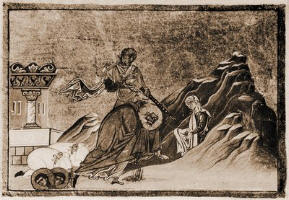
The Works Of Dionysius The Areopagite Volumes 1&2 -Dionysius The Areopagite
SECTION V
Last of all, the Priest calls the ordained to the supremely Divine Communion, shewing religiously that the ordained, if he would really attain to the monastic and single elevation, will not merely contemplate the sacred mysteries within them, nor come to the communion of the most holy symbols, after the fashion of the middle Rank, but, with a Divine knowledge of the holy things received by him, will come to the reception of the supremely Divine Communion, in a manner different from that of the holy people. Wherefore, the Communion of the most holy Eucharist is also given to the sacerdotal Orders, in their consecrating dedications, by the Hierarch who consecrated them, at the end of their most holy sanctifications, not only because the reception of the supremely Divine Mysteries is the consummation of each Hierarchical reception, but because all the sacred Orders, according to their capacity, partake of the self-same common and most godly gifts, for their own elevation and perfection in deification. We conclude, then, that the holy Mystic Rites are, purification, and illumination, and consecration. The Leitourgoi are a purifying rank, the Priests an illuminating, and the Godlike Hierarchs a consecrating. But the holy people is a contemplative Order. That which does not participate in the sacred contemplation and communion, is a Rank being purified, as still under course of purification. The holy people is a contemplative Rank, and that of the single Monks is a perfected Rank. For thus our Hierarchy, reverently arranged in Ranks fixed by God, is like the Heavenly Hierarchies, preserving, so far as man can do, its God-imitated and Godlike characteristics.

 Support Site Improvements
Support Site Improvements